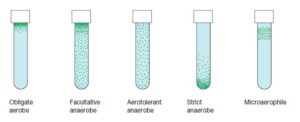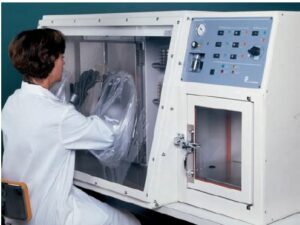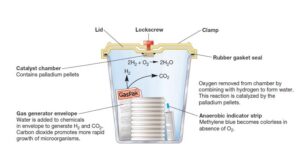Introduction
- The microorganisms respond differently when there is a variation in levels of nutrients.
- The growth of microorganisms is highly affected by the nature of the surroundings.
- Microorganisms are ubiquitous, they adapt themselves to survive in unfavorable environments.
- The microorganisms which thrive and grow in extreme environments where normal microorganisms can’t survive are called extremophiles.
- The major factors which influence the growth of microorganisms are pH, water activity, temperature, oxygen level, pressure, and radiation.
- These factors help to study the ecological distribution of microorganisms.
Temperature
- The temperature of surroundings greatly affects microorganisms.
- Growth depends on the temperature sensitivity of enzymes present in the bacteria.
- Each enzyme has an optimal temperature at which it catalyzes the reaction
- As temperature increases from the low temperature, the rate of catalysis increases. [every 10°C double the rate of enzymatic reaction]
- At beyond certain point, a further increase in temperature decreases the growth.
Biological Effects of temperature on microorganisms
- High temperature is lethal, it damages the microorganism by denaturing enzymes, and other important protein which carries out the vital tasks for growth of microorganisms.
- Temperature also affects the cell membrane, at low temperature, lipid bilayer solidifies whereas at high temperature, and it melts and disintegrates.
Growth is depended on cardinal temperature
- Cardinal temperature includes minimum, optimum and maximum growth temperatures.

- The cardinal temperature is not fixed for particular species; it depends on environmental factors like pH and the available nutrient.
- For E.g., a protist, Crithidia fasciculate, found in the mosquito’s gut, will grow on media at 22- 27°C, can’t grow at 33 – 34°C without adding extra nutrients which includes vitamins, amino acids, etc.
Microorganisms on the basis of temperature range, are classified into five classes:
-
Psychrophiles
- Psychrophilic microorganisms can grow well at 0°C, the optimum growth temperature is less than 15°C, and the maximum temperature is around 10°C.
- Found mostly in arctic & antarctic regions, because the ocean is less than 5°C, and is a suitable niche for psychrophiles.
- A psychrophilic protist, Chlamydomonas nivalis, is present on glaciers, turning it into pink color due to its bright red spores.
- Other species of psychrophiles include Pseudomonas, Vibrio, Bacillus, Arthobacter, Photobacterium, and Moritella
- Psychrophilic archaea, Methanogenium, was found in Ace Lake of Antarctica
- Adaptation:
- The psychrophilic cell membrane has high amounts of unsaturated fatty acids due to which the bilayer remains semifluid.
- The temperature more than 20°C, cell disruption in psychrophiles occurs in which cellular constituents leaks out of the membranes
-
Psychrotrophs
- Psychotropics microorganisms are also called facultative psychrophiles
- Many species grow between ranges around 0 – 7°C, the temperature for optimum growth range is 20 – 30°C, and the maximum temperature is around 35°C.
- Psychotropics are responsible for food spoilage in refrigerators. e.g., Listeria monocytogenes, Pseudomonas fluorescens
-
Thermophiles
- Microorganisms can grow at 55°C or higher, the minimum temperature is around 45°C, and the optimum temperature is around 55- 65°C.
- Found in habitats including hot springs, composts, etc., Geobacillus stearothermophilus, Thermus aquaticus, Cyanidium caldarium, Chaetomium thermophile
- Adaptation:
- The enzymes which are heat stable are present more in numbers,
- Heat stable proteins are highly organized, hydrophobic interior more with H- bond and non-covalent bonds strengthen the structure.
- A large amount of amino acids which includes proline makes the polypeptide chains flexible.
- The thermophilic bacterial DNA is stabilized by histone-like proteins.
- Membrane lipids are stable at high temperatures because they form abundant saturated, and more branched fatty acid chains.
- The thermophiles that belong to the archaeal group have ether linkages in their lipids present in the membranes which protect the bilayer from high temperatures which usually cause hydrolysis.
-
Hyperthermophiles
- Some thermophiles can thrive above 90°C; growth at maximum temperature is above 100°C, the temperature optimum for growth is within the range 80°C and 113°C.
- They don’t grow well less than 55°C. e. g., Pyrococcus abyssi & Pyrodictium occultum found in the seafloor hot areas.

Solutes and Water Activity
- The membrane is selectively permeable, affected by variations in osmotic concentration of surroundings.
- In hypotonic solutions, microbial cells burst because water influx enters the cell.
- In a hypertonic solution, water flows out of the cells, which causes plasmolysis.
- Dehydration of cell subjected to hypertonic conditions damages the membrane of the cell and make cell metabolic inactive.
Adaption:
- In the hypertonic solution, cells can lessen the osmotic concentration of cytoplasm, by the inclusion bodies
- The membrane of some bacteria & archaea constitutes mechanosensitive [MS] channels, acts as an escape valve that protects the cells from bursting by allowing solutes to exit the cell membrane.
- The membranes of microbial cells stretch because of cellular swelling and hydrostatic pressure in hypertonic conditions.
- Many protists have contractile vacuoles to release excess water.
- Many microorganisms maintain the protoplasm’s osmotic concentration, by using compatible solutes; it doesn’t interfere in cell growth or metabolism.
- Most microorganisms raise their cytoplasmic osmotic concentrations in hypertonic conditions by synthesizing or uptaking choline, proline, and other amino acids, which increases the amount of K+ ions.
- Some photosynthetic fungi and protists use sucrose & polyols [such as arabitol, glycerol, & mannitol] to increase cytoplasmic osmotic concentration.
- Polyols & amino acids are considered ideal solutes, they don’t disrupt the structure and functions of enzymes.
- Some microorganisms that adapt themselves in excess hypertonic environments are called Halophiles.
- Grow in the presence of NaCl or other salt concentrations above 0.2M.
- Extreme Halophiles require a high amount of salt concentration such as NaCl about 2- 6.2 M.
- The archaeon Halobacterium has been recovered from the Dead Sea, also known as the Great Salt Lake situated in Utah.
- Halophiles, accumulate large amounts of potassium, to achieve hypertonic conditions, the level of K ions ranges to 4 – 7 M.
Water activity
- The surroundings’ osmotic concentration affects the growth of microorganisms.
- The degree of available water is expressed quantitatively by the term called water activity (aw).
 aw = Water activity
aw = Water activity
Psoln = vapor pressure of the solution
P water = Pure water
- Adaptation– Some microorganisms grow in low water activity value, it maintains high cytoplasmic solute concentration for water retention. For eg., Saccharomyces rouxii grows in solutions containing sugar with low water activity values i.e., 6
pH
- The solution’s H+ ion activity is measured by pH.
- It is also mentioned as the negative logarithm of the concentration of H+ion ( expressed in molarity)
pH= -log[H+]= log[1/ H+]
- The environment pH drastically affects the growth.
- Individual species have an optimum range of pH for their growth.
- Acidophiles – Can grow optimally within the range of pH 0 – 5.5.
- E.g., Fungi grow well in an acidic environment around pH 4 – 6;
- Photosynthetic protists and many archaea are considered as acidophiles for e.g., Sulfolobus acidocaldarius, archaea that are found in hot springs which is acidic.
- Neutrophiles – can grow between the range of pH 5.5 – 8.0.
- E.g., most protists and bacteria e.g., E.Coli, Euglena, and Paramecium are neutrophiles.
- Alkalophile- prefers to grow between pH ranges of 0 to 11.5.
- E.g., Bacillus alcalophilus, Natronobacterium
- Extreme Alkalophiles- optimum pH range for growth is pH 10 or more.
Adaptation:
- Microorganisms react to change in pH in different ways to maintain cytoplasmic pH at a neutral scale because extreme fluctuations in cytoplasmic pH can affect microorganisms by inhibiting enzyme activity & membrane transport proteins or by hampering the plasma membranes.
- In neutrophiles, cytoplasmic pH is maintained by the exchange of K+ performed by an antiport of the membrane.
- Extreme alkalophiles, e.g., Bacillus alcalophilus, exchange internal Na+ for external K+ and internal buffering additionally helps in pH homeostasis.
- If the pH of the surrounding is too acidic, microorganisms e.g., E.Coli, Salmonella enterica, synthesize arrays of proteins in feedback to acidic tolerance mechanisms, a proton translocating ATPase synthesizes more number of ATP or protons is pumped outside the cell.
- If surrounding pH reduces to 4.5 or less, acid shock protein & heat shock proteins are produced which prevent acid denaturing of the proteins and helps in refolding of proteins that are denatured.
NOTE: Microorganisms tend to change their own environment by releasing acidic or alkaline metabolic waste; growth inhibition due to pH change is prevented by the addition of buffer in the medium. Phosphate is commonly used as a buffer in media.
Oxygen Concentration
- The growth of microbes and oxygen are correlated to the metabolism process.
- In process of aerobic respiration, oxygen acts as a terminal e– acceptor in the electron transport chain; in eukaryotes, oxygen is needed in the synthesis of sterols & unsaturated fatty acids.
- Aerobic microorganisms require oxygen for their survival and growth
- Anaerobic microorganisms can thrive well in absence of oxygen.
- Obligate aerobes are those microorganisms, whose growth is completely dependent on oxygen.
- Facultative anaerobes can efficiently grow in the presence of oxygen, but it is not a necessary factor.
- Aerotolerant anaerobes, for e.g., Enterococcus faecalis , growth doesn’t depend on oxygen and grow well both in the absence and presence of oxygen.
- Obligate Anaerobes, e.g., Fusobacterium, Bacteroides, are oxygen-sensitive, and it’s lethal if they are exposed to them.
- Both aerotolerant and obligate anaerobes use anaerobic respiration such as fermentation to produce energy.
- Microaerophiles, e.g., Campylobacter get damaged at normal atmospheric levels of oxygen (20%), for their growth oxygen levels, less than the range of 2 – 10% is required.
- A medium that includes thioglycollate broth is needed to lower the oxygen level as it has the tendency to reduce oxygen.

Adaptation:
- Obligate anaerobes cannot survive in oxygen presence but can be isolated in the oxic environment, because they usually form an association with facultative anaerobes that utilize the available oxygen, providing the environment for obligate anaerobes to sustain.
- Oxygen accepts an electron, therefore, it tends to be reduced, some combination of reduction product such as superoxide radicals, hydrogen peroxide & hydroxyl radical, it is generally harmful of microorganisms.
- Most microorganisms produce enzymes to protect themselves against reduced oxygen products which are usually toxic for the cells.
- Obligate aerobes and also facultative anaerobes produce enzyme superoxide dismutase & catalase, they catalyze the elimination of the superoxide radical and hydrogen peroxide.
- Aerotolerant microorganisms lack catalase; it uses manganese ions to deal with the superoxide radical, by destroying it.
For culturing of anaerobic microorganisms several methods are used:
- The thioglycollate or cysteine is used to reduce oxygen and carries out its elimination in the medium.
- in the anaerobic system, elimination of oxygen is done by removal of air by vacuum pump, by adding carbon dioxide in small amounts favors the anaerobic growth.

- Use of GasPak Jar for culturing a small number of anaerobes.

Pressure
- Microorganisms found in deep oceans around 1000 m deep or more, where hydrostatic pressure is around 600 – 1,100 atm and the temperature is around 2 – 3°C, are known as barotolerant.
- Some microorganisms found in deep-sea invertebrate’s gut of the amphipods (shrimp-like crustaceans) and sea cucumbers are known as barophilic, grow efficiently in high pressures.
- E.g., Barophiles found in the Mariana trench, many bacterial genera such as Photobacterium, Colwellia, and some archaea are thermo-barophiles such as Methanocaldococcus jannaschii , Pyrococcus spp,.
Radiation
- Radiations of any form are lethal to microorganisms.
- Ionizing radiation, short-wavelength & high energy cause atoms to lose electrons.
- Mainly two types of ionizing radiation are used i.e., X rays, produced artificially, and gamma rays, emitted during radioactive decay.
- The ionizing radiation at low levels induce mutations, a high level is fatal for microorganisms.
- Microorganisms e.g., Deinococcus radiodurans and endospores of the bacteria are resistant to the ionizing radiation
- Ultraviolet radiation, a major source is solar energy, destroys all types of microorganisms.
- UV radiation induces the thymine dimers formation in the DNA, which inhibits DNA replication.
- Some microorganisms adapt themselves against UV radiation of shorter wavelength by mechanisms of DNA repair.
Reference and Sources
- https://biologywriteup.blogspot.com/2014/10/control-of-microbial-growth-bacterial.html
- https://www.slideshare.net/UmeshMaskare/bacteria-bacteria-structure
- https://intelligentmisstag.com/science/article/abs/pii/S0007153686800560vhbo4855crae
- https://quizlet.com/146934517/cell-bio-part-1-flash-cards/
- https://courses.lumenlearning.com/microbiology/chapter/the-effects-of-ph-on-microbial-growth/
- https://www.sciencedirect.com/topics/biochemistry-genetics-and-molecular-biology/acidophile
- https://www.chemguide.co.uk/organicprops/aminoacids/enzymes2.html
Also Read:
- Water as a Microbial Habitat
- What is Gene Expression?
- Second Golden Age of Microbiology
- Vector: properties, types and characteristics
- Bioinformatics: What Does the Sequence Mean?
- Tetanus – Etiology, Pathogenesis, and Treatment
- Microorganisms in Benthic Marine Environments
- Normal Microbiota of the Healthy Human body
- Membrane Structure, Its Related Proteins and Hydropathy Plot
- Microbiology Disciplines: Bacteria, Viruses, Fungi, Archaea and Protists

The concepts of the notes real helped in my research.